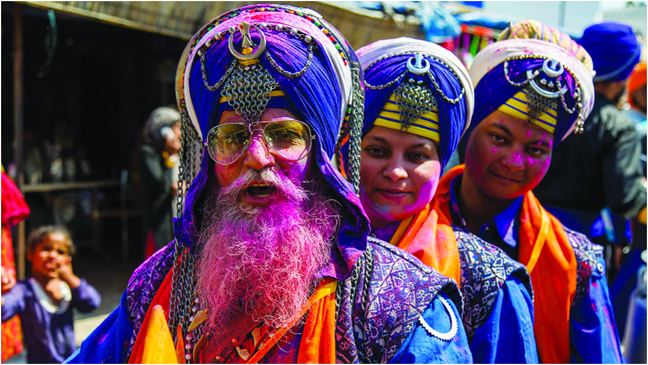
Popularity of Holi can be gauged from the number of names Holi has in different states. Also of great interest is the story behind each of these names.
As one moves across from one state to another, one can surely discover the myriad shades of human emotions behind the story that goes with each of these names of holi.
These stories will make you feel proud of the rich cultural diversity of India. Besides, what is to be appreciated is the underlying strong bond of unity that binds this uniquely culturally diverse country.
Even the Gods that are worshiped on Holi differ in different corners of the country. The way the festival is celebrated also differs but the spirit is same – the one of love and brotherhood. Inspite of their uniqueness in different states, the festival is considered to be the one which enhances the secular fabric of India.
Lathmaar Holi
In what is known as the hub of holi in India – Barsana, Holi is known as Lathmaar Holi. Sounds violence?? There is more violece than the name signals off. The stick is in the hands of the women on this day and the men need to work a lot to save themselves from the immensely charged up womenfolk.
The birth place of Lord Krishna’s beloved Radha, Barsana celebrates Holi with extreme enthusiasm as Krishna was famous for playing pranks on Radha and gopis. In fact, it was Krishna who started the tradition of colours by first applying colour on Radha’s face.
Womenfolk, of Barsana it seems, after thousands of centuries want to take a sweet revenge of that prank of Krishna. Even men have not left their mischief and are still eager to apply colour on the women of Barsana.
Dulandi Holi
Holi recieves this name in the state of Haryana. Here, bhabhi – the brothers wife gets an upper hand on the day of holi. And, devar’s – husband’s younger brothers need to watchout.
The bhabhi’s on this day get a social sanction on Holi to beat their devars and make them pay the price of all the pranks they played on them for the entire year. Bhabhi’s roll up their saris in the form of a rope in a mock rage, and give a good run to their devars.
In the evening, devars are supposed to bring sweets for their dear bhabhi.
Besides, there is also a tradition of breaking the pot of buttermilk hung high in the street by forming a human pyramid.
Rangpanchami
People of Maharashtra commonly know this festival of colours by the name of Rangpanchami as the play of colours is reserved for the fifth day here. Locals of Maharashtra also know Holi as Shimga or Shimgo.
The festival is particularly popular amongst fisher folk. They celebrate it in on a large scale and revel in the festivities by singing, dancing and merry-making. This special dance provide them means to release all their repressed feelings, needs and desires. People also utter sound through their mouths in a peculiar fashion by striking their mouths with the back of their hands.
Basant Utsav
Holi by the name of Basant Utsav is celebrated with fervour in the state of West Bengal. The tradition of Vasantotsav, meaning Spring Festival was started by poet and Nobel laureate Rabindranath Tagore at Shantiniketan, the University he founded.
What is appreciated is the grace and diginified manner in which Vasant Utsav is celebrated in West Bengal as compared to boisterous Holi witnessed in most parts of India. Boys and girls joyfully welcome Spring, the season of hope not just with colours but with songs, dance, chanting of hymns in the serene ambiance of Shantiniketan. Anybody who got a chance to witness this elegant way of celebrating Holi in Bengal remembers it with fond memory for the rest of his life.
Dol Purnima
Holi is also known by the name of Dol Purnima in West Bengal.
Early in the morning, on the Dol Purnima day students dress up in saffron-coloured clothes and wear garlands of fragrant flowers. They sing and dance to the accompaniment of musical instruments presenting an enchanting view to the onlookers and a memory to cherish for years.
The festival is also known as ‘Dol Jatra’, ‘Dol Purnima’ or the ‘Swing Festival’. The festival is celebrated in a dignified manner by placing the idols of Krishna and Radha on a picturesquely decorated palanquin which is then taken round the main streets of the city. The devotees take turns to swing them while women dance around the swing and sing devotional songs. Throughout the procession men keep spraying coloured water and colour powder, ‘abeer’ at them.
Hola Mohalla
Holi gets this joyful name in the state of Punjab. The festival is celebrated in an entirely different manner, it’s meaning and significance also shifts a little here.
Hola Mohalla is actually an annual fair that is organised in a large scale at Anandpur Sahib in Punjab on the day following the festival of Holi. Practise of holding a fair of this kind was initiated by Guru Gobind Singh, the tenth Sikh guru. Purpose of the fair was to physically strengthen the Sikh community by holding military exercises and mock battles.
The festival is celebrated for three consecutive days, in which members of Sikh community display their physical strength by performing dare-devil acts like bareback horse-riding, standing erect on two speeding horses, Gatka (mock encounters), tent pegging etc. This is followed by music and poetry competition to lighten the charged up atmosphere.
A number of durbars are also held where Sri Guru Granth Sahib is present and kirtan and religious lectures take place. This helps strengthening the soul of community. On the last day a long procession, led by Panj Pyaras, starts from Takth Keshgarh Sahib, one of the five Sikh religious seats, and passes through various important gurdwaras like Qila Anandgarh, Lohgarh Sahib, Mata Jitoji and terminates at the Takth.
For people visiting Anandpur Sahib, langars (voluntary community kitchens) are organized by the local people as a part of sewa (community service). Raw materials like wheat flour, rice, vegetables, milk and sugar is provided by the villagers living nearby. Women volunteer to cook and others take part in cleaning the utensils. Traditional cuisine is served to the pilgrims who eat while sitting in rows on the ground.





Be the first to comment